Abstract
To investigate the pathogenesis of macroglobulinemia in the tropical splenomegaly syndrome (TSS), we assessed the functional activity of B lymphocytes and T cell subsets in a pokeweed mitogen-driven assay of immunoglobulin synthesis. Mononuclear cells from patients with TSS produced more IgM than cells from village or from distant controls. This appeared to result from a decrease in the number and/or activity of suppressor T cells of the T8+ phenotype. The lack of functional suppressor T lymphocytes was associated with the presence in sera from patients with TSS of IgM antibodies that specifically killed T8+, 9.3-, 60.1+ T cells from normal donors. These results support the hypothesis that macroglobulinemia in TSS results from defective immunoregulatory control of B cell function, and that this may be caused by lysis of suppressor T cells by specific lymphocytotoxic antibodies produced by patients with this syndrome.
Full text
PDF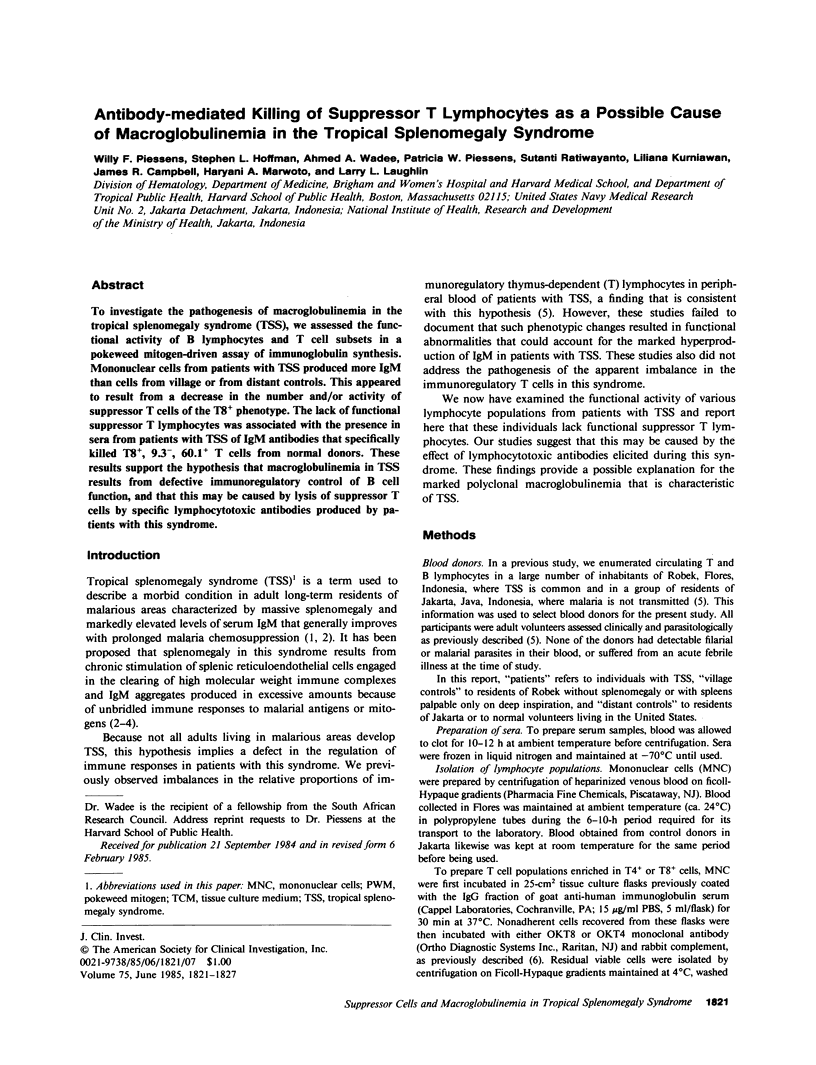
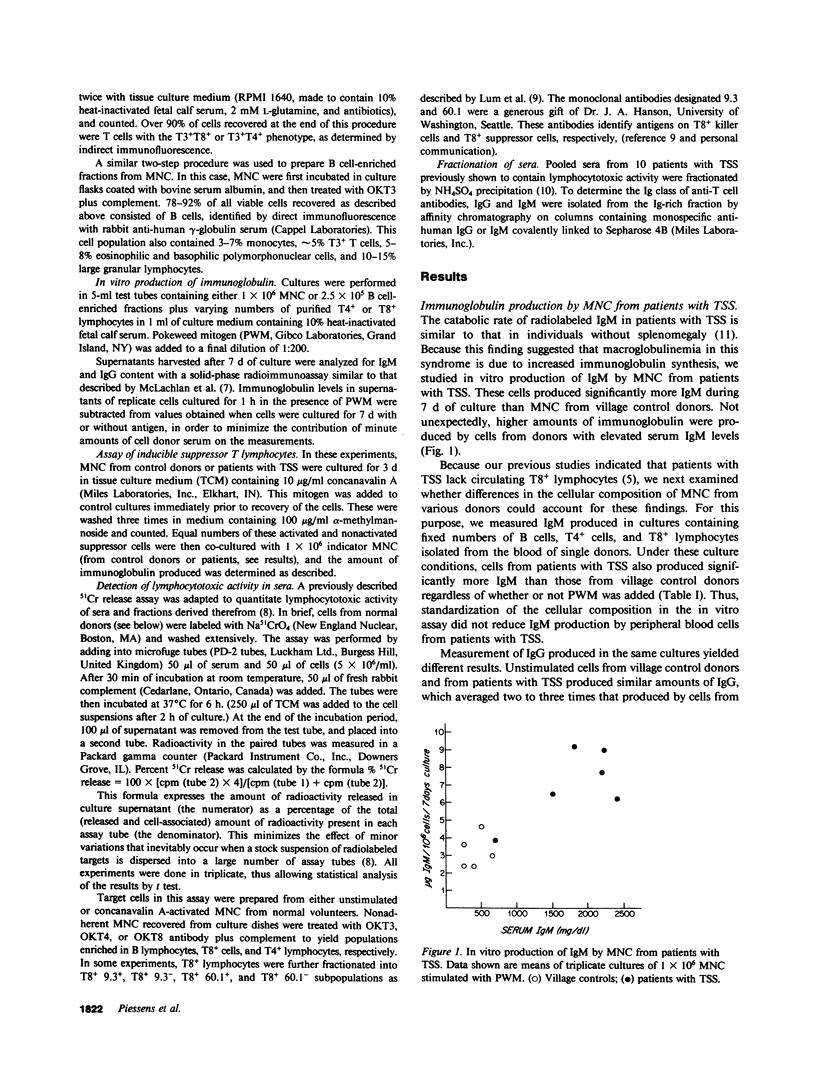
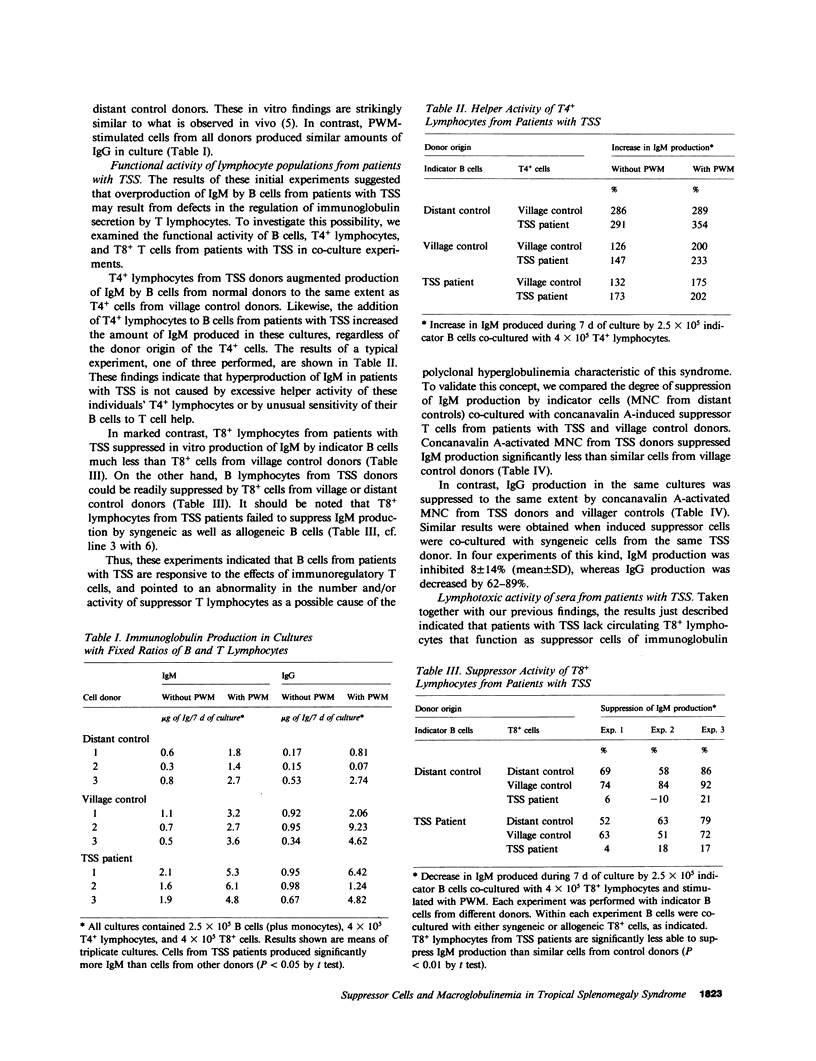
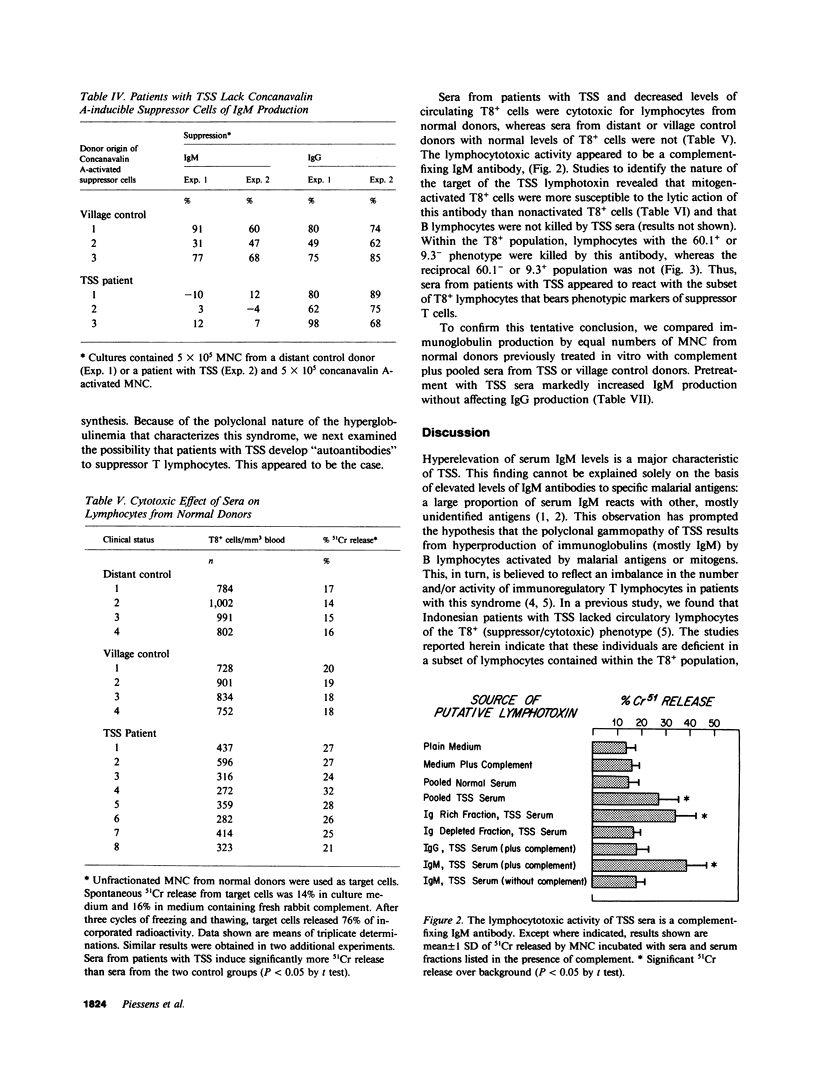
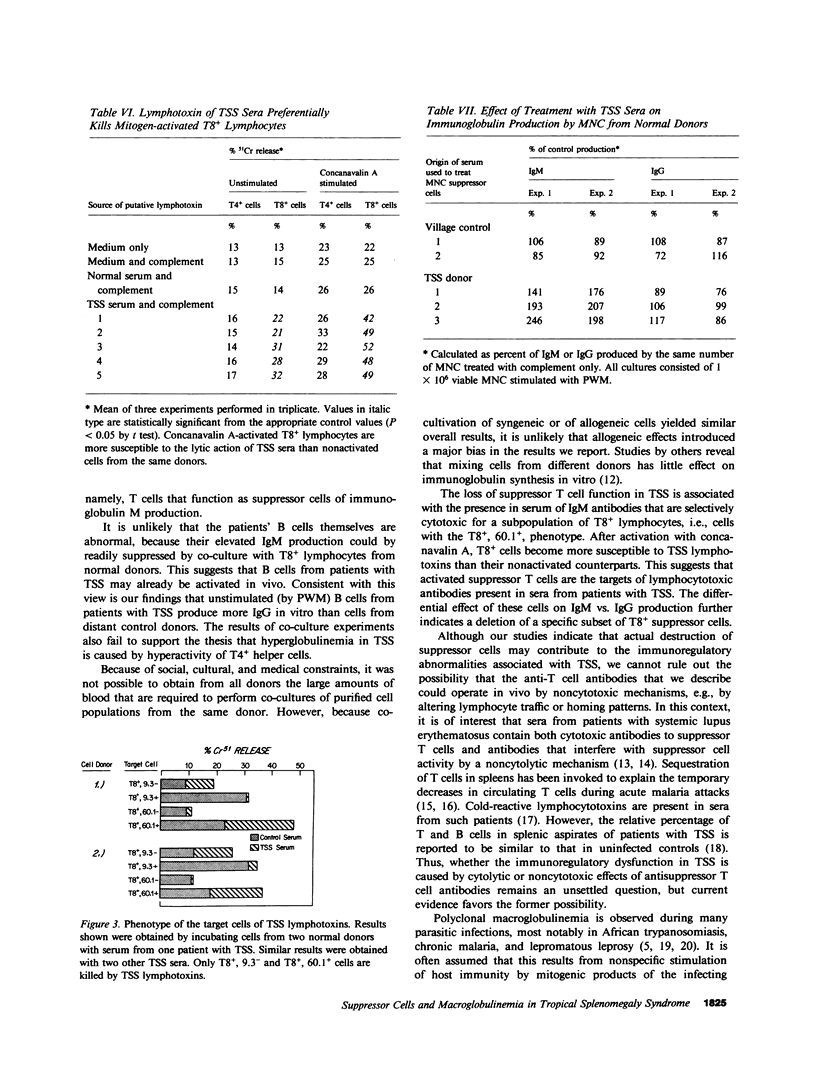
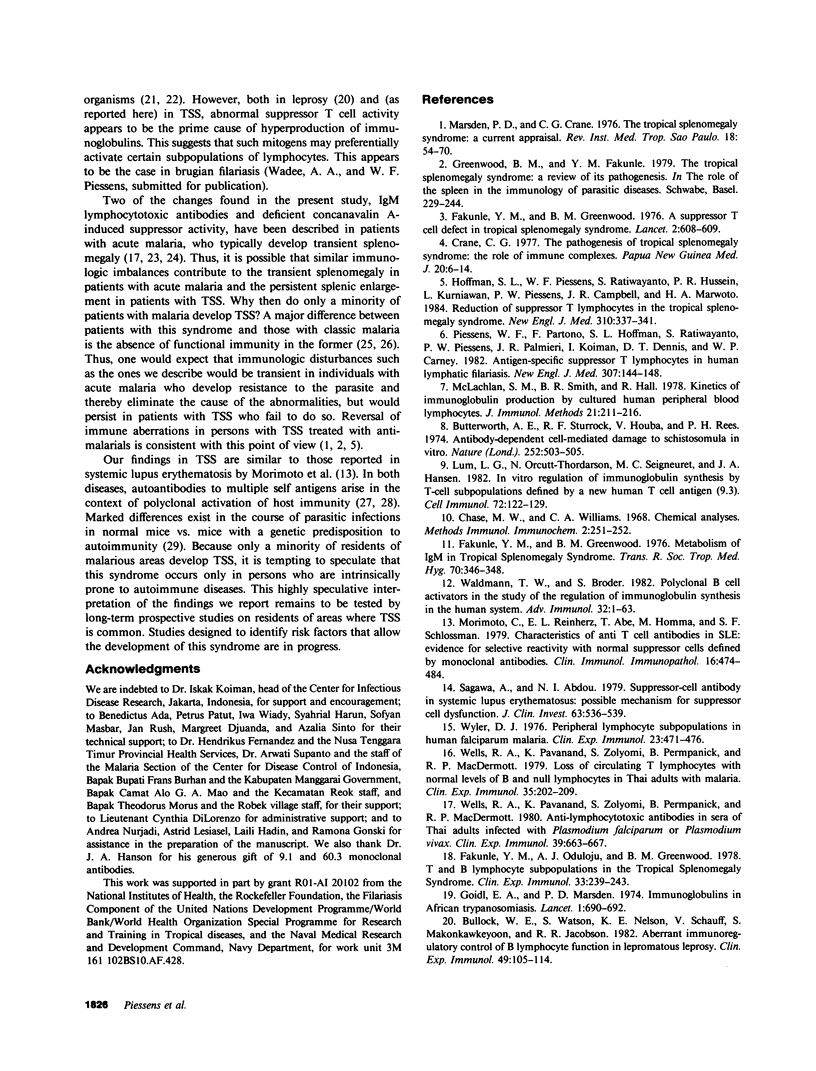
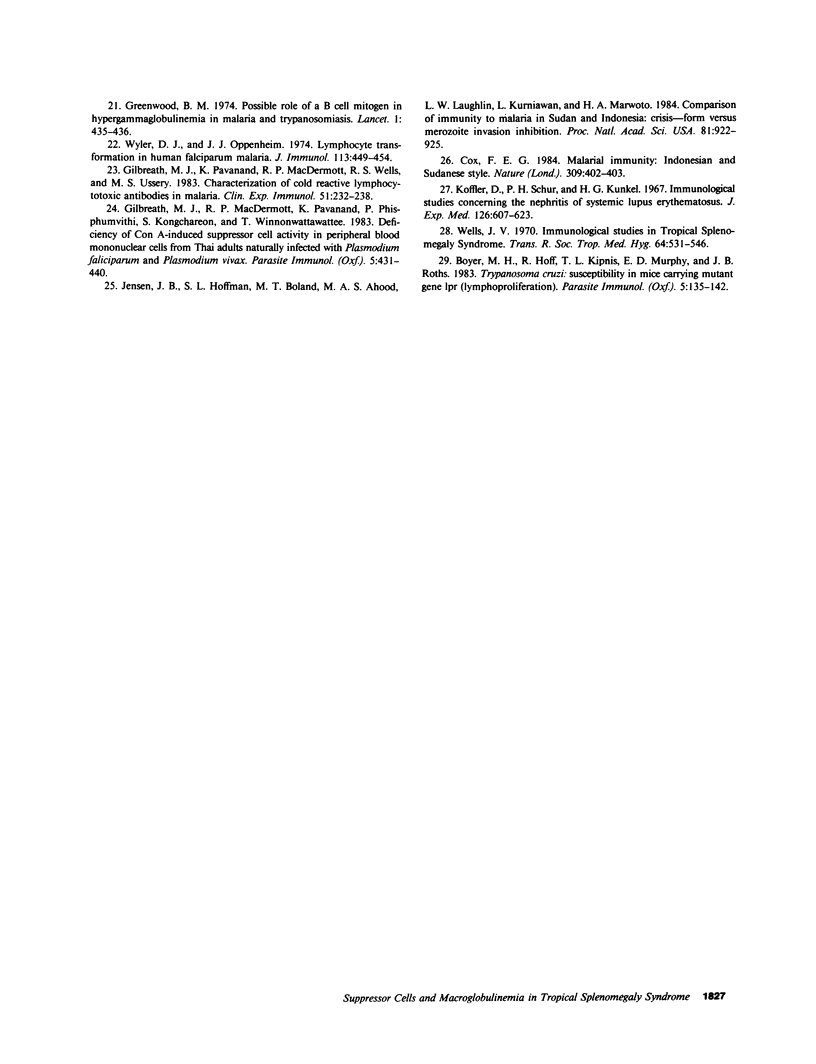
Selected References
These references are in PubMed. This may not be the complete list of references from this article.
- Boyer M. H., Hoff R., Kipnis T. L., Murphy E. D., Roths J. B. Trypanosoma cruzi: susceptibility in mice carrying mutant gene lpr (lymphoproliferation). Parasite Immunol. 1983 Mar;5(2):135–142. doi: 10.1111/j.1365-3024.1983.tb00731.x. [DOI] [PubMed] [Google Scholar]
- Bullock W. E., Watson S., Nelson K. E., Schauf V., Makonkawkeyoon S., Jacobson R. R. Aberrant immunoregulatory control of B lymphocyte function in lepromatous leprosy. Clin Exp Immunol. 1982 Jul;49(1):105–114. [PMC free article] [PubMed] [Google Scholar]
- Butterworth A. E., Sturrock R. F., Houba V., Rees P. H. Antibody-dependent cell-mediated damage to schistosomula in vitro. Nature. 1974 Dec 6;252(5483):503–505. doi: 10.1038/252503a0. [DOI] [PubMed] [Google Scholar]
- Cox F. E. Indonesian and Sudanese style. 1984 May 31-Jun 6Nature. 309(5967):402–403. doi: 10.1038/309402a0. [DOI] [PubMed] [Google Scholar]
- Crane G. G. The pathogenesis of tropical splenomegaly syndrome--the role of immune complexes. P N G Med J. 1977 Mar;20(1):6–13. [PubMed] [Google Scholar]
- Fakunle Y. M., Greenwood B. M. A suppressor T-cell defect in tropical splenomegaly syndrome. Lancet. 1976 Sep 18;2(7986):608–609. doi: 10.1016/s0140-6736(76)90671-1. [DOI] [PubMed] [Google Scholar]
- Fakunle Y. M., Greenwood B. M. Metabolism of IgM in the tropical splenomegaly syndrome. Trans R Soc Trop Med Hyg. 1976;70(4):346–348. doi: 10.1016/0035-9203(76)90097-3. [DOI] [PubMed] [Google Scholar]
- Fakunle Y. M., Oduloju A. J., Greenwood B. M. T- and B-lymphocyte subpopulations in the tropical splenomegaly syndrome (TSS). Clin Exp Immunol. 1978 Aug;33(2):239–243. [PMC free article] [PubMed] [Google Scholar]
- Gilbreath M. J., MacDermott R. P., Pavanand K., Phisphumvithi P., Kongchareon S., Wimonwattrawatee T. Deficiency of Con A-induced suppressor cell activity in peripheral blood mononuclear cells from Thai adults naturally infected with Plasmodium falciparum and Plasmodium vivax. Parasite Immunol. 1983 Sep;5(5):431–440. doi: 10.1111/j.1365-3024.1983.tb00758.x. [DOI] [PubMed] [Google Scholar]
- Gilbreath M. J., Pavanand K., MacDermott R. P., Wells R. A., Ussery M. A. Characterization of cold reactive lymphocytotoxic antibodies in malaria. Clin Exp Immunol. 1983 Feb;51(2):232–238. [PMC free article] [PubMed] [Google Scholar]
- Goidl E. A., Marsden P. D. Letter: Immunoglobulins in African trypanosomiasis. Lancet. 1974 Apr;1(7859):690–690. doi: 10.1016/s0140-6736(74)93253-x. [DOI] [PubMed] [Google Scholar]
- Greenwood B. M. Possible role of a B-cell mitogen in hypergammaglobulinaemia in malaria and trypanosomiasis. Lancet. 1974 Mar 16;1(7855):435–436. doi: 10.1016/s0140-6736(74)92386-1. [DOI] [PubMed] [Google Scholar]
- Hoffman S. L., Piessens W. F., Ratiwayanto S., Hussein P. R., Kurniawan L., Piessens P. W., Campbell J. R., Marwoto H. A. Reduction of suppressor T lymphocytes in the tropical splenomegaly syndrome. N Engl J Med. 1984 Feb 9;310(6):337–341. doi: 10.1056/NEJM198402093100601. [DOI] [PubMed] [Google Scholar]
- Jensen J. B., Hoffman S. L., Boland M. T., Akood M. A., Laughlin L. W., Kurniawan L., Marwoto H. A. Comparison of immunity to malaria in Sudan and Indonesia: crisis-form versus merozoite-invasion inhibition. Proc Natl Acad Sci U S A. 1984 Feb;81(3):922–925. doi: 10.1073/pnas.81.3.922. [DOI] [PMC free article] [PubMed] [Google Scholar]
- Koffler D., Schur P. H., Kunkel H. G. Immunological studies concerning the nephritis of systemic lupus erythematosus. J Exp Med. 1967 Oct 1;126(4):607–624. doi: 10.1084/jem.126.4.607. [DOI] [PMC free article] [PubMed] [Google Scholar]
- Lum L. G., Orcutt-Thordarson N., Seigneuret M. C., Hansen J. A. In vitro regulation of immunoglobulin synthesis by T-cell subpopulations defined by a new human T-cell antigen (9.3). Cell Immunol. 1982 Sep 1;72(1):122–129. doi: 10.1016/0008-8749(82)90289-1. [DOI] [PubMed] [Google Scholar]
- Marsden P. D., Crane G. G. The tropical splenomegaly syndrome. A current appraisal. Rev Inst Med Trop Sao Paulo. 1976 Jan-Feb;18(1):54–70. [PubMed] [Google Scholar]
- McLachlan S. M., Smith B. R., Hall R. Kinetics of immunoglobulin production by cultured human peripheral blood lymphocytes. J Immunol Methods. 1978;21(3-4):211–216. doi: 10.1016/0022-1759(78)90147-3. [DOI] [PubMed] [Google Scholar]
- Morimoto C., Reinherz E. L., Abe T., Homma M., Schlossman S. F. Characteristics of anti-T-cell antibodies in systemic lupus erythematosus: evidence for selective reactivity with normal suppressor cells defined by monoclonal antibodies. Clin Immunol Immunopathol. 1980 Aug;16(4):474–484. doi: 10.1016/0090-1229(80)90189-0. [DOI] [PubMed] [Google Scholar]
- Piessens W. F., Partono F., Hoffman S. L., Ratiwayanto S., Piessens P. W., Palmieri J. R., Koiman I., Dennis D. T., Carney W. P. Antigen-specific suppressor T lymphocytes in human lymphatic filariasis. N Engl J Med. 1982 Jul 15;307(3):144–148. doi: 10.1056/NEJM198207153070302. [DOI] [PubMed] [Google Scholar]
- Sagawa A., Abdou N. I. Suppressor-cell antibody in systemic lupus erythematosus. Possible mechanism for suppressor-cell dysfunction. J Clin Invest. 1979 Mar;63(3):536–539. doi: 10.1172/JCI109333. [DOI] [PMC free article] [PubMed] [Google Scholar]
- Waldmann T. A., Broder S. Polyclonal B-cell activators in the study of the regulation of immunoglobulin synthesis in the human system. Adv Immunol. 1982;32:1–63. doi: 10.1016/s0065-2776(08)60720-8. [DOI] [PubMed] [Google Scholar]
- Wells J. V. Immunological studies in tropical splenomegaly syndrome. Trans R Soc Trop Med Hyg. 1970;64(4):531–546. doi: 10.1016/0035-9203(70)90075-1. [DOI] [PubMed] [Google Scholar]
- Wells R. A., Pavanand K., Zolyomi S., Permpanich B., MacDermott R. P. Loss of circulating T lymphocytes with normal levels of B and 'null' lymphocytes in Thai adults with malaria. Clin Exp Immunol. 1979 Feb;35(2):202–209. [PMC free article] [PubMed] [Google Scholar]
- Wells R. A., Pavanand K., Zolyomi S., Permpanich B., Macdermott R. P. Anti-lymphocytotoxic antibodies in sera of Thai adults infected with Plasmodium falciparum or Plasmodium vivax. Clin Exp Immunol. 1980 Mar;39(3):663–667. [PMC free article] [PubMed] [Google Scholar]
- Wyler D. J., Oppenheim J. J. Lymphocyte transformation in human Plasmodium falciparum malaria. J Immunol. 1974 Aug;113(2):449–454. [PubMed] [Google Scholar]
- Wyler D. J. Peripheral lymphocyte subpopulations in human falciparum malaria. Clin Exp Immunol. 1976 Mar;23(3):471–476. [PMC free article] [PubMed] [Google Scholar]


